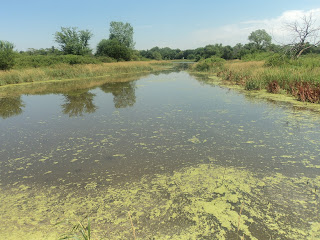Trail: Grindstone Nature Trail
Hike Location: Grindstone Nature Area
Geographic Location: south side of Columbia ,
MO (38.92584, -92.31166)
Length: 1.7 miles
Difficulty: 3/10 (Easy/Moderate)
Date Hiked: June 2016
Overview: A lollipop loop through an old agricultural area
and atop limestone cliffs.
Area Information: https://www.como.gov/parksandrec/park/grindstone-nature-area/
Directions to the trailhead: Near Columbia ,
take I-70 to US 63 (exit 128A). Exit and
go south on US 63. Drive US 63 south 1.9
miles to SR 740. Exit and turn right on
SR 740. Drive SR 740 west 0.9 miles to Old
US 63 and turn left on Old US 63. Drive
Old US 63 south 0.4 miles to the park entrance on the right. Turn right to enter the park, and park in the
only parking lot.
The hike: Located just off campus from the University
of Missouri Missouri used by early
settlers, passed through this area in the early 1800’s. Corn and other crops were grown on this land
for many years, and some evidence of this land’s agricultural past will be seen
on this hike. The City of Columbia
purchased the land in 1975 as part of a greenbelt plan, thus forming the park.
True to its
name, Grindstone Nature Area has only a parking lot, a restroom building, a
picnic shelter, and an off-leash dog area for amenities, so nature is allowed to
take center stage. Two concrete bike
paths have trailheads here, and several miles of natural surface trails pass
through the Nature Area. Grindstone
Nature Area also features two creeks that, like many of central Missouri ’s
waterways, are lined with tall limestone cliffs. While several routes are possible, the route
suggested here takes you past some of this land’s agricultural remnants and
atop the limestone cliffs.
 |
| Trailhead area: Hinkson Creek Trail |
This hike
starts at the rear of the parking lot on the crushed gravel Hinkson Creek Trail,
which is also open to mountain bikes. The
Hinkson Creek Trail links the nature area to the University
of Missouri
After
crossing Grindstone Creek, look for the mulch trail that exits the bike path on
the right. This mulch path is the start
of the hiker-only Grindstone Nature Trail, so angle right to begin the Nature
Trail. Less than 200 feet later, you
pass a tall concrete silo on the right, one of the reminders of this area’s agricultural
history.
 |
| Concrete silo |
Just past
the silo, the trail splits to form its loop.
This hike will continue straight on a path that heads up the right side
of a prairie planting and use the narrow path exiting right into the woods as
its return route. None of the trails at
Grindstone Nature Area are marked or signed.
With the many narrow and winding trails that exist here, this trail
system could really benefit from some better trail markings to make trails and
trail intersections easier to identify.
The
grass-dirt trail heads northwest in almost a straight line with the prairie
planting on your left and the woods on your right. Continue straight wherever side trails exit
left or right. At one point the trail
seems to head into the woods on a mulch path, but it quickly comes back out
into the prairie.
 |
| Hiking through the prairie |
Just shy of
0.7 miles, you reach a T-intersection at the northwest edge of the prairie with
options going left and right. The trail
going left quickly leads back to the gravel Hinkson Creek Trail, and it could be
used if you wanted a hike entirely in the prairie. To also see the limestone cliffs for which
this part of Missouri is famous,
turn right to begin following a sewer line, a reminder of this hike’s suburban
setting.
Upon
reaching the edge of the prairie, turn left to head into the woods, which
features a large number of cottonwood trees.
The trail surface turns to packed dirt as it curves right to begin
paralleling Hinkson Creek. Some narrow
trails exit left and right, but the main trail assumes a southeasterly course
with the creek several feet to your left.
As I mentioned above, some trail markings would really help here. Also, the packed dirt soil can become quite
slippery when wet, so take your time and watch your step.
 |
| Climbing gradually |
 |
| View from cliff top |
 |
| Looking down from the cliffs at Grindstone Creek |
The trail
becomes a bit rockier and narrower as you continue southeast. A brief descent precedes a brief ascent to
the bluffs overlooking Grindstone Creek.
The creek waters are visible below, but trees block any expansive
views. A final descent brings you to the
mulch trail beside the old concrete silo to close the loop. A left turn returns you to the packed gravel
Hinkson Creek Trail, where another left turn returns you to the parking lot to
complete the hike.





































